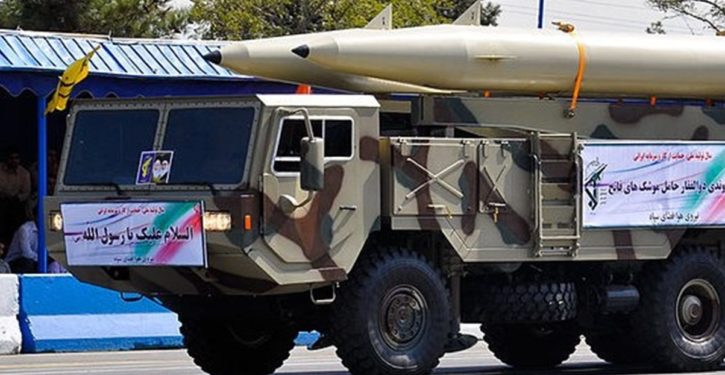
Last week, numerous news sites picked up on a report that Iran has been helping to construct a missile production complex in Syria near the coastal city of Baniyas, north of Tartus.
Analysts at ImageSat International (ISI) published an analysis of Israeli satellite imagery that suggested a similarity between structures at the Syrian site and structures at “an Iranian missile factory near Tehran.”
The comparison images used by ISI show buildings from the missile factory complex at Parchin, southeast of Tehran (see images below). This area of Parchin has been involved in manufacturing Scud, Fateh 110, Zelzal, and other shorter-range missiles for some time. Surface-to-air missiles and antitank missiles are also reportedly manufactured there, along with certain parts for the intermediate-range Shahab and Ghadr missile programs.


Of particular interest in the comparison images is the set of Iranian structures with the berms around them. A tight array of such buildings, like the one seen in the factory complex at Parchin, is characteristic of a solid-propellant production facility for ballistic missiles. (See further below for overview images and context.)

If the construction in Syria east of Baniyas develops along a similar line – i.e., if the long building with the tower, surrounded by the berm, becomes part of a tight array of neatly bermed structures – it would be likely that the buildings in question had a similar purpose.
Syria has had the capability to manufacture missiles of the same quality for some years now. (Iran was helping Assad build missile production facilities in Aleppo and Homs since at least 2007, including a capability to produce solid missile fuel.) The missile facility near Baniyas doesn’t necessarily represent a step forward for Syria in terms of missile quality – although it may. Building a newer facility like Iran’s current missile complex could allow Syria to manufacture a new generation of missiles with little up-tooling.
But the new facility comes on top of other evidence that Iran is expanding the capacity to build missiles – and probably other weapons components – in western Syria and Lebanon. The number of reports on this is accelerating, and importantly, it keeps identifying more locations.
Moreover, those locations have some interesting qualities besides the similarity of structures noted by ISI.
One is the concentration of manufacturing plants and possible special-weapons structures within a few kilometers of each other, around comparatively rural, hilly terrain, taking advantage of water sources and the potential for tunneling.
The other is the reportedly extensive use of underground chambers.
In other words, zoom out from the individual buildings identified by ISI, and the overall character of what’s being developed looks, in concept, much like the complex of Iranian facilities at Parchin, in conjunction with the Khojir missile complex to the northwest of it, where the key manufacturing work is reportedly done on the Shahab and Ghadr missile programs. In each grouping – Iranian and Syrian – there is also an area suspected of hosting nuclear weapons-related work (the “Plan 10” area at Parchin, and the facility near Qusayr on the border with Lebanon. See links above).



Iran seems to be developing a sort of mini-Parchin in western Syria and Lebanon. It’s an important question what could come off the assembly line there on Day 1. But the more important question – since Syria can already produce the items the newly-built facilities appear suitable for – is what could be facilitated down the road.
Of course, putting some of the capability in Lebanon is clearly meant to give Hezbollah a stand-alone capability of its own for weapons at a certain level. That solves a big problem for Iran.
But the locations also do something important for Iran’s strategic intentions. Manufacturing some of the most popular arms in the world, on the other side of the Red Sea and Suez Canal, would facilitate the movement and sale of those arms.
Israel has been able to halt at least some Iranian arms shipments bound for Gaza and Lebanon over the last 10 years, by interdicting them in the Red Sea and Horn of Africa.
If the weapons are trafficked directly out of both Syria and Lebanon, Israel’s ability – and even motivation – to do something about them will have to navigate a different set of wickets. It will actually be NATO’s problem, more than Israel’s, to stop arms shipments headed for places other than Gaza.

If Iran has Russia’s tacit protection for such trafficking, which is not unlikely, it’s a good question what the nations of the NATO West will even do about it.
Israel will probably encounter decision points at which it will be necessary to destroy the manufacturing complexes in Lebanon altogether. The question will be when.
A final note about putting facilities in Syria, where Israel is somewhat less likely to attempt full-scale destruction of them. This move functions as a form of prepositioning for Iran. If an Iranian force moved across Iraq and Syria in a pincer move on Israel, it would of course bring armaments with it. But it wouldn’t begin moving unless the campaign started with supporting maneuvers first – maneuvers than would have Syria as their hub. The ability to employ standoff weapons from Syria, as preparation for such a move, and then fall in on a new supply of arms would be a significant advantage for the strategy.
Look for Syria to be capable of producing and storing a lot of the newest cruise and short-range ballistic missiles Iran has, before this is done.



